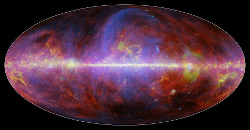HEAPOW: Dust to Dust (2015 Feb 09)
Posted: Mon Feb 09, 2015 4:02 pm
 HEAPOW: Dust to Dust (2015 Feb 09)
HEAPOW: Dust to Dust (2015 Feb 09)
In order to see far, you need to understand what's close. So in order to understand the primordial cosmic background radiation, the remnant radiation from the Big Bang that started flying towards us when the first electrons combined with the first protons, corrections need to be made for the radiation emitted by everything in our home Galaxy - stars, hot dust, electrons trapped by magnetic fields, molecules, everything. The Planck mission, designed to study minute fluctuations in the cosmic background radiation in order to understand where the stars in our Galaxy came from, needs to understand the radiation those stars emit, along with the radiation emitted by the molecules and dust those stars produced. After more than four years observing this cosmic background radiation, the Planck mission has developed a very good measure of that "annoying" foreground radiation. The image above is an image of our Milky Way obtained by Planck, showing the distribution of gas, charged particles and several types of dust. These data are helping us re-evaluate our understanding of the formation and growth of the Universe, the distribution of gas and dust in our own Milky Way, and the importance of foreground dust on the detection of gravity waves from the period of inflation just after the big bang.
JPL: Planck Mission Explores the History of Our Universe
ESA: Planck Publications
| << Previous HEAPOW | High Energy Astrophysics Picture of the Week | Next HEAPOW >> |